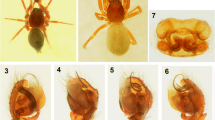Abstract
Records of sympatry between Alouatta caraya and A. clamitans are rare despite their extensive range overlap. An example of their current sympatry and the rediscovery of free-ranging potential hybrids of A. caraya and A. clamitans in the forests of the Upper Paraná River, Southern Brazil, are reported in this paper. Eight groups were observed in the study area: five monospecific groups of A. caraya, two of A. clamitans, and a group containing two adult males and two adult females of A. caraya and a sub-adult male and two adult females identified as Alouatta sp. The color of the last three individuals was a mosaic between the two species; this is consistent with previously described variations in museum specimens collected in the Paraná River in the 1940s that had been identified as potential hybrids. The results from this study emphasize the need for scientific studies in the region of the Ilha Grande National Park, one of the few regions in the Paraná River that currently harbors both howler species.


Similar content being viewed by others
References
Aguiar LM (2006) Os primatas do corredor do Alto Rio Paraná (região de Porto Rico, estados do Paraná e Mato Grosso do Sul): ocorrência, georreferenciamento e parâmetros populacionais [dissertation]. Curitiba (PR): Universidade Federal do Paraná. 104p. Available from: Universidade Federal do Paraná, Curitiba, PR
Aguiar L, Ludwig G, Svoboda WK, Teixeira GM, Hilst CLS, Shiozawa MM, Malanski LS, Mello AM, Navarro IT, Passos FC (2007) Use of traps to capture black and gold howlers (Alouatta caraya) on the Islands of the upper Paraná River, Southern Brazil. Am J Primatol 69:241–247
Bicca-Marques JC, Calegaro-Marques C (1998) Behavioral thermoregulation in a sexually and developmentally dichromatic Neotropical primate, the black-and-gold howling monkey (Alouatta caraya). Am J Primatol 106:533–546
Campos JB (2001) Parque Nacional de Ilha Grande, re-conquista e desafios. IAP/Coripa, Maringá
Chame M, Olmos F (1997) Two howler species in Southern Piauí, Brazil? Neotrop Primates 5:74–77
Codenotti TL, Silva VM, Albuquerque VJ, Camargo EW, Silveira RMM (2002) Distribuição e situação atual de conservação de Alouatta caraya (Humboldt, 1812) no Rio Grande do Sul, Brasil. Neotrop Primates 10:132–141
Cortés-Ortiz L, Bermingham E, Rico C, Rodríguez-Luna E, Sampaio I, Ruiz-García M (2003) Molecular systematics and biogeography of the Neotropical monkey genus, Alouatta. Mol Phylogenet Evol 26:64–81
Defler TR (2004) Primates of Colombia. Conservation International, Bogotá
Di Bitetti MS (2005) Perspectivas para a conservação de primatas em Misiones. In: Galindo-Leal C, Câmara IG (eds) Mata Atlântica: Biodiversidade, Ameaças e Perspectivas. Fundação SOS Mata Atlântica, São Paulo, Conservação Internacional, Belo Horizonte, pp 194–199
Di Bitetti MS, Placci G, Brown AD, Rode DI (1994) Conservation and population status of the brown howling monkey (Alouatta fusca clamitans) in Argentina. Neotrop Primates 2:1–4
Ferrari SF (2004) Biogeography of Amazonian primates. In: Mendes SL, Chiarello AG (eds) A primatologia no Brasil 8. IPEMA/SBPr, Vitória, pp 101–122
Gregorin R (2006) Taxonomia e variação geográfica das espécies do gênero Alouatta Lacépède (Primates, Atelidae) no Brasil. Rev Bras Zool 23:64–144
Groves CP (2001) The taxonomy of primates. Smithsonian Institution Press, Washington
Hirano ZMB (2003) Secreção epidérmica de Alouatta guariba clamitans (Primates, Atelidae) [Thesis]. Ribeirão Preto (SP): Universidade de São Paulo, 144p. Available from: Universidade de São Paulo, Ribeirão Preto
Hirsch A, Landau EC, Tedeschi ACM, Menegheti JO (1991) Estudo comparativo das espécies do gênero Alouatta Lacèpéde, 1799 (Platyrrhini, Atelidae) e sua distribuição geográfica na América do Sul. In: Rylands AB, Bernardes AT (eds) A primatologia no Brasil 3. Fundaçao Biodiversitas, Belo Horizonte, pp 239–262
Iwanaga S, Ferrari SF (2002) Geographic distribution of red howlers (Alouatta seniculus) in Southwestern Brazilian Amazonia, with notes on Alouatta caraya. Int J Primatol 23:1245–1256
Lorini ML, Persson VG (1990) A contribuição de Andre Mayer a história natural no Paraná (Brasil) II. Mamíferos do terceiro planalto paranaense. Arq Bras Biol Tecnol 33:117–132
Peres CA, Janson CH (1999) Species coexistence, distribution, and environmental determinants of neotropical primate richness: a community-level zoogeographic analysis. In: Fleagle JG, Janson CH, Reed KE (eds) Primates communities. Cambridge University Press, Cambridge, pp 55–74
Pinto LP, Setz EZF (2000) Sympatry and new locality for Alouatta belzebul discolor and Alouatta seniculus in the Southern Amazon. Neotrop Primates 8:150–151
Rylands AB, Schneider H, Langguth A, Mittermeier RA, Groves CP, Rodríguez-Luna E (2000) An assessment of the diversity of new world primates. Neotrop Primates 8:61–93
Souza MC, Romagnolo MB, Kita KK (2004) Riparian vegetation: ecotones and plant communities. In: Thomaz SM, Agostinho AA, Hahn NS (eds) The Upper Paraná River and its floodplain: physical aspects, ecology and conservation. Backhuys Publishers, Leiden, pp 353–367
Wallace RB, Painter RLE, Rumiz DI, Taber AB (2000) Primate diversity, distribution and relative abundances in the Rios Blanco y Negro Wildlife Reserve, Santa Cruz Department, Bolivia. Neotrop Primates 8:24–28
Acknowledgments
We thank Marcelo Brunning, Rodrigo F. Moro-Rios, Gabriela Ludwig, Eduardo Carrano, Marcio R. Pie, APA das Ilhas e Várzeas do Rio Paraná, APA Municipal de Alto Paraíso, Parque Nacional de Ilha Grande, Universidade Federal do Paraná, Conselho Nacional de Pesquisa e Desenvolvimento Tecnológico (CNPq). Dr Jean P. Boubli and two other reviewers provided helpful comments on the manuscript. Contract grant sponsor: Conselho Nacional de Desenvolvimento Científico e Tecnológico (CNPq).
Author information
Authors and Affiliations
Corresponding author
Additional information
Contribution number 1637 of the Departamento de Zoologia, Universidade Federal do Paraná, Caixa Postal 19020, 81531-980, Curitiba, Paraná, Brasil.
About this article
Cite this article
Aguiar, L.M., Mellek, D.M., Abreu, K.C. et al. Sympatry between Alouatta caraya and Alouatta clamitans and the rediscovery of free-ranging potential hybrids in Southern Brazil. Primates 48, 245–248 (2007). https://doi.org/10.1007/s10329-007-0039-0
Received:
Accepted:
Published:
Issue Date:
DOI: https://doi.org/10.1007/s10329-007-0039-0




